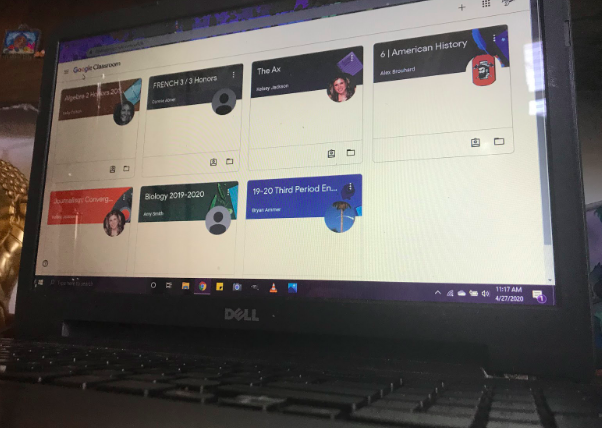Saved by the desktop
Distance learning curveball impacts teachers
COVID-19 forced schools to shut down for the sake of social distancing in early March. As a result, teachers have had to learn how to properly teach their students at a distance. Through the use of video chats, Google Classroom and some optimism, teachers made it through the rest of the year.
Teachers experienced a variety of emotions while adapting to distance learning. On one hand, teachers felt that this is a time of excitement, for they have more time to spend with their family and to explore new hobbies.
“I have enjoyed the experience immensely because I have been able to spend time with my wife and children,” K.C. Weaver, an English I and IIH teacher, said. “I am able to do the planning and grading when they are doing their work or when the kids are playing.”
On the other hand, some felt that they are spending even more time on their work than before, which caused stress.
“This has been more work than my first year of teaching,” Mary Haucke-Davis, a French teacher, said. “It’s really impossible to teach a language from a distance.”
Over the past few years, Oakwood has hired a great deal of new teachers for a range of departments. Although all teachers have to endure this struggle, newer teachers have had to experience this at the very beginning of their career.
“It’s all the work and none of the fun,” Ellie Randall, who is in her first year of teaching Modern World History, said. “I miss my kiddos!”
Even though there is some excitement in the change, there were also certain difficulties teachers faced. The main difficulty was a lack of communication from students. This can vary from getting students to attend meetings or complete late work.
“Communication is more difficult and slow because students are not in my classroom listening to my voice each day, and I can’t tap on their desk if they lose focus,” Ian Callon, a geometry and BC calculus teacher, said. “Time management can be very difficult for students, especially if they are not used to setting their own schedule.”
But teachers were not the only ones dealing with this problem. Students were also having difficulties with staying connected to teachers and other students in order to complete work. There are still flaws in technology that make it less efficient than real-life interactions.
“I’ll try to email or text people to ask for help before I go to a teacher, because they’re working enough already,” Lizzi Clock (10) said. “Some people simply take forever to respond, so it quickly gets annoying.”
Despite the fact that this is a stressful time for everyone, there was a learning opportunity embedded in this experience. Some teachers learned about different ways they can use technology to effectively teach their students once everything returns to normal.
“Some of the advanced organizers and videos may find a place in my normal classroom,” Jay Lane, an algebra and calculus teacher, said. “Many of the things I have learned in creating activities and assignments using Desmos will be applicable to future creative lessons.”
Teachers and students alike can agree: the current times are a challenge. Thanks to the past decade’s advancements in technology, people can continue the means of education and stay in touch with one another. It is up to us to decide how we use technology, for it can keep us together or tear us apart.


